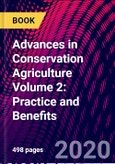Audience: Crop scientists researching low-input and organic agriculture, soil scientists, national organisations responsible for improving agricultural practices and sustainability.
Table of Contents
1. Practice and benefits of Conservation Agriculture systems: Amir Kassam, University of Reading, UK; and Laila Kassam, Animal Think Tank, UK;2. Crop and cropping systems management practices and benefits in Conservation Agriculture systems: Muhammad Farooq, Sultan Qaboos University, Oman, University of Agriculture, Pakistan, and The University of Western Australia, Australia; Ahmad Nawaz, Bahauddin Zakariya University, Pakistan; Yashpal Singh Saharawat, International Center for Agricultural Research in the Dry Areas (ICARDA), Lebanon; Timothy Reeves, The University of Melbourne, Australia; and Kadambot Siddique, The University of Western Australia, Australia;
3. Soil management practices and benefits in Conservation Agriculture systems: Michele Pisante, University of Teramo, Italy; Angelica Galieni, Council for Agricultural Research and Economics and Research Centre for Vegetable and Ornamental Crops, Italy; Gottlieb Basch, University of Évora, Portugal; Theodor Friedrich, Food and Agriculture Organization of the United Nations (FAO), Italy; and Fabio Stagnari, University of Teramo, Italy;
4. Weed management practices and benefits in Conservation Agriculture systems: Gottlieb Basch and Fernando Teixeira, University of Évora, Portugal; and Sjoerd W. Duiker, Penn State University, USA;
5. Insect pest and disease management practices and benefits in Conservation Agriculture systems: a case of push-pull practice: Z. R. Khan, International Centre of Insect Physiology and Ecology (icipe), Kenya; A. W. Murage, Kenya Agricultural and Livestock Research Organization (KALRO), Kenya; and J. O. Pittchar and C. A. O. Midega, International Centre of Insect Physiology and Ecology (icipe), Kenya;
6. Nutrient management practices and benefits in Conservation Agriculture systems: Stephane Boulakia, Florent Tivet and Olivier Husson, Centre de coopération Internationale en Recherche Agronomique pour le Développement (CIRAD), France; and Lucien Séguy, AgroécoRiz, France;
7. Carbon management practices and benefits in Conservation Agriculture systems: Carbon sequestration rates João Carlos de Moraes Sá, State University of Ponta Grossa, Brazil; Florent Tivet, Centre de coopération Internationale en Recherche Agronomique pour le Développement (CIRAD), France; Rattan Lal, The Ohio State University, USA; Ademir de Oliveira Ferreira, Federal Rural University of Pernambuco, Brazil; Clever Briedis, Brazilian Agricultural Research Corporation, Agricultural Instrumentation Center, Brazil; Thiago Massao Inagaki, Technical University of Munich, Germany; and Daniel Potma Gonçalves and Jucimare Romaniw, State University of Ponta Grossa, Brazil;
8. Carbon management practices and benefits in Conservation Agriculture systems: soil organic carbon fraction losses and restoration: João Carlos de Moraes Sá, State University of Ponta Grossa, Brazil; Florent Tivet, CIRAD, France; Rattan Lal, The Ohio State University, USA; Ademir de Oliveira Ferreira, Federal Rural University of Pernambuco, Brazil; Clever Briedis, Brazilian Agricultural Research Corporation, Agricultural Instrumentation Center, Brazil; Thiago Massao Inagaki, Technical University of Munich, Germany; and Daniel Potma Gonçalves and Jucimare Romaniw, State University of Ponta Grossa, Brazil;
9. Biodiversity management practices and benefits in Conservation Agriculture systems: Scott Day, Treelane Farms Ltd, Canada; Ademir Calegari, Agricultural Research Institute of Paraná State (IAPAR), Brazil; Alessandra Santos, Marcus Cremonesi, Lilianne Maia and Wilian Demetrio, Federal University of Paraná, Brazil; and Marie L. C. Bartz, Coimbra University, Portugal;
10. Conservation Agriculture: climate change mitigation and adaptation benefits: Emilio J. Gonzalez Sanchez, Universidad de Córdoba, Spain, European Conservation Agriculture Federation (ECAF), Belgium and Asociación Española Agricultura de Conservación. Suelos Vivos (AEAC.SV), Spain; Oscar Veroz-Gonzalez, Asociación Española Agricultura de Conservación. Suelos Vivos (AEAC.SV), Spain; Manuel Morena-Garcia and Rafaela Ordoñez-Fernandez, IFAPA Centro Alameda del Obispo, Spain; Jesus A. Gil-Ribes and Julio Roman-Vazquez, Universidad de Córdoba, Spain; Antonio Holgado-Cabrera, IFAPA Centro Alameda del Obispo, Spain; Amir Kassam, University of Reading, UK; Gordon Conway, Imperial College London, UK; Saidi Mkomwa, African Conservation Tillage Network, Kenya; Paula Triviño-Tarradas, Antonio Miranda-Fuentes and Francisco Marquez-Garcia, Universidad de Córdoba, Spain; and Rosa M. Carbonell-Bojollo, IFAPA Centro Alameda del Obispo, Spain;
11. Benefits of Conservation Agriculture to farmers and society: Patrick Wall, Independent Consultant - Sustainable Agricultural Systems, Mexico; Christian Thierfelder, International Maize and Wheat Improvement Center (CIMMYT), Zimbabwe; Peter Hobbs, Cornell University, USA; Jon Hellin, International Rice Research Institute (IRRI), The Philippines; and Bram Govaerts, International Maize and Wheat Improvement Center (CIMMYT), Mexico;
12. Social benefits of Conservation Agriculture systems: Rafael Fuentes Llanillo, Tiago Santos Telles and Dimas Soares Junior, Agricultural Research Institute of Paraná State (IAPAR), Brazil; Sara Kaweesa, University of Natural Resources and Life Sciences (BOKU), Austria; and Anne-Marie B. Mayer, Independent Nutrition and Agriculture Consultant, UK;
13. Harnessing ecosystem services with Conservation Agriculture: Amir Kassam, University of Reading, UK; Emilio J. Gonzalez Sanchez, Universidad de Córdoba, Spain,European Conservation Agriculture Federation (ECAF), Belgium and Asociación Española Agricultura de Conservación. Suelos Vivos (AEAC.SV), Spain; Tom Goddard, Alberta Agriculture and Forestry, Canada; Li Hongwen, Conservation Tillage Research Centre, China Agriculture University, China; Ivo Mello, Instituto Rio Grandense do Arroz, Brazil; Saidi Mkomwa, African Conservation Tillage Network, Kenya; Francis Shaxson, Land Husbandry Group, Tropical Agricultural Association, UK; and Theodor Friedrich, Food and Agriculture Organization of the United Nations (FAO), Italy;
14. Rehabilitating degraded and abandoned agricultural lands with Conservation Agriculture systems: Telmo Jorge Carneiro Amado, Federal University of Santa Maria, Brazil; Carlos Alexandre Costa Crusciol, São Paulo State University (UNESP), Brazil; Claudio Hideo Martins da Costa, Universidade Federal de Goiás, Brazil; Otávio dos Anjos Leal, Catarinense Federal Institute, Brazil; and Luan Pierre Pott, Federal University of Santa Maria, Brazil








